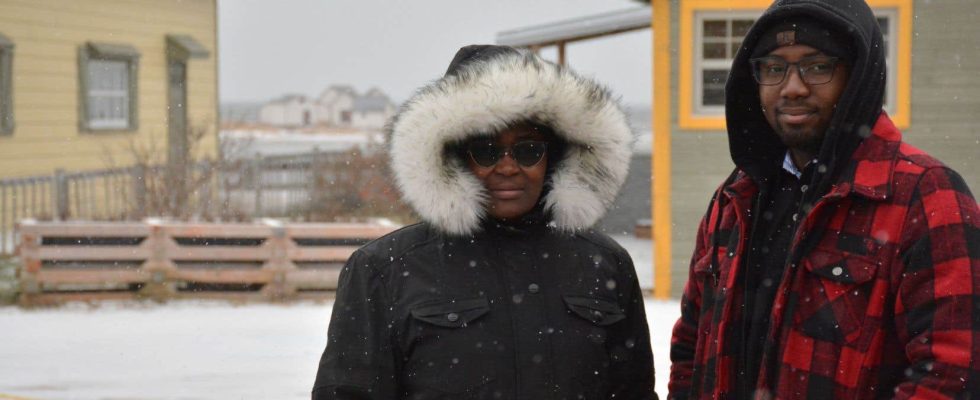The North Shore, a vast and largely uninhabited territory, is suffering from the worst demographic decline in Quebec. Despite its remoteness, harsh winters and difficult access, the region still manages to attract new arrivals. The duty traveled its coastline over 800 kilometers to understand the reasons that lead these immigrants to the ends of the world. First in a series of four texts.
15 hours from Montreal to the northeast, the asphalt road ends up stopping in front of the tundra. On the North Shore, scattered across a string of villages of barely a hundred people, a growing number of new arrivals are finding their welcome there. From Tadoussac to Natashquan.
“Fifteen hours on the road is good, it’s still an hour less than a flight from Kinshasa to Montreal,” notes with a smile Éloge Buenimio, 27 years old, who arrived at the end of Quebec about barely two months. From his native Congo, he came all this way to work at the Natashquan general store.
It was the latter’s administration that went to pick him up at a job fair in Montreal. “It was either that or we closed a few days a week,” quickly explains Louise Caouette, the co-owner of Marché Natashquan, visibly overwhelmed by the organization of the business.
Éloge is not the only newcomer to Gilles Vigneault’s hometown, which is the permanent home of around 250 people. Chancellor, originally from Cameroon, accompanies him to the general store. The local hardware store also hired people from abroad. The school hires two Afro-descendants.
“It’s the best place to adapt [au Québec] », underlines Éloge. Locals gave him his first coat and invited him to go hunting, a popular activity in the area. He refused. For now. “When you arrive somewhere, if people dance on the left foot, you have to dance on the left foot,” the young man philosophizes.
Their recent arrival does not seem to be making any waves, quite the contrary, according to the oldest people in the village. “They are really valiant,” we whisper from underneath the coat.
Their smiles also go a long way. “He’s really friendly, always laughing,” says Éloge’s roommate, originally from the Îles-de-la-Madeleine.
From 0% to 8%
These new inhabitants can be found all along the coast. Their arrival in recent months coincides with the recent explosion in the number of temporary workers… and the war in Ukraine.
Olena Akymova and her three daughters urgently left southern Ukraine when bombs started raining down around them. After a detour to France, where the little family learned French, they chose this remote strip of land, wedged between the boreal forest and the Gulf of Saint Lawrence, as their destination. “We wanted peace and quiet. Priorities changed with the war,” explains Olena, in Russian. Now, “the worst is the wind.”
An embryonic Slavic community thus blossomed this year in a territory already populated by Innus, Quebecers, Acadians and Newfoundlanders. Elena Vasileva, a Russian of origin, and her partner, Benoît de Mulder, ended their immigrant journey in Minganie, a few minutes by car from Olena’s house.
“We looked at the census before we arrived, and it showed 0%. [d’immigrants]. Rivière-au-Tonnerre has 65 inhabitants. […] With our arrival and that of Olena’s family, we must be at 8%,” jokes Benoît, of Belgian origin, who works remotely.
They enjoy the privilege of having been able to move by choice after years in Montreal. But, as with the others, it was the calm of the place that convinced them to raise their child there. “The people here have a selfless kindness,” marvels the father, who was able to count on his new neighbor to set up a new home. “There is an isolation in the city that we don’t have here. »
That, and the Northern Lights appearing in the sky at the same time as the passage of Duty.
More heterogeneous than we think
Barely 15% of new Quebecers choose to settle outside the Montreal region, according to the latest figures from the Institut du Québec. On the North Shore, where we deplore the biggest demographic decline in Quebec, each of its new faces can change the dynamic. When it’s not the general store that stays open longer, it’s a local café that simply finds the staff needed to operate. A primary school in the tiny village of Tête-à-la-Baleine was even able to keep its doors open when a Ukrainian family moved there last year, adding to the already present cohort the few more students who were missing .
The challenge, however, will be to retain these newcomers.
These stories of rerooting do indeed exist. For example, Natalia Marcilese put down her Argentinian roots a decade ago in the small village of Franquelin, in the Haute-Côte-Nord, just 8 hours from Montreal.
“We decided to settle here because of that,” she says, her hand outstretched towards the sea, the cliffs and the lights of Baie-Comeau on the horizon.
In her renovated wooden “shack”, she says that the strangest look anyone ever gave her during her adventure in Quebec came in the eyes of the government agent, in Paris, when she told him of his desire to move to the North Shore. If one day she were to leave her adopted village, it would be so that her son had access to activities and an education. The village school has been closed for two or three years, and other families are very rare in the area.
Otherwise, she feels at home, even after 10 years. “I keep my identity. I don’t delete it,” she says. Her child speaks Spanish and her refrigerator is stocked with local specialties. “The accent is not a factor of discrimination. On the contrary, I feel valued. »
And it is the territory that has the last word. Little Lucas, his son, asks his mother, during the visit Duty : “Mom, can I have a rifle for Christmas?” »
This report is supported by the Local Journalism Initiative, funded by the Government of Canada.
